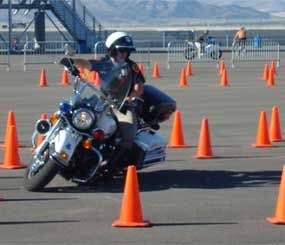By Pat Reavy
Deseret Morning News
 Utah Highway Patrol motorcycle training. (Photo courtesy of Salt Lake City PD) |
| Related Article: Starting a motor unit for your department |
SALT LAKE CITY, Utah — They may be the most visible officers of the Salt Lake Police Department.
They lead parades, escort dignitaries, direct traffic, block streets, catch drunken drivers, and their rides have probably been photographed more than any other vehicle in the department’s fleet.
Salt Lake’s motorcycle cops have always worn many different hats or, in this case, helmets.
Sgt. Ken Pearce wrote in the memory book of the Salt Lake Motor Squad: “A Motor should be able to direct traffic, herd sheep, change a flat, plan a parade, handle a fatal, process a DUI, write any report, diagram a scene, comfort the dying, console the living, handle any call, set a bone, be counted on, be part of a team, act alone, take orders, give orders, analyze a new problem, solve equations, program a computer, fight efficiently, die gallantly. Specialization is for insects.”
The Motor Squad is not only one of the department’s most visible squads, but also one of its oldest. This spring will mark the division’s 100th anniversary.
“It almost caught us by surprise,” said Motor Squad Sgt. Cameron Platt, who admitted even he couldn’t believe the motor division is now a century old.
The Salt Lake Motor Squad was started in 1909. At that time, there were four officers in the squad who all had to purchase their own motorcycles, which at that time were essentially bicycles with engines attached, Platt said.
By the mid-1950s, Salt Lake City had experienced a boom in growth, which resulted in an increase in traffic. Platt said those were the years the squad really took off.
From about the 1950s until 1995, there were a dozen motorcycle officers. That number was increased in 1995 to 24.
Today, there are 22 members of the squad with two current vacancies. The group is asked to participate in an average of 340 special events per year on top of the hundreds of traffic incidents officers respond to during their regular course of duty, including an average of 900 DUI stops each year.
The advantage of a motorcycle over a patrol car is its ability to maneuver through traffic to get to an accident scene or weave through stopped vehicles to catch up to a vehicle that needs to be pulled over.
The Motor Squad is one of the most coveted assignments in the department, and one of the most difficult units to join. Aside from the fact that very few officers ever leave the squad, being accepted to the unit means officers must complete a tough driving certification test and renew it twice a year.
“It’s a safety factor. We want to make sure they can stop and maneuver the bike,” Platt said.
Motorcycle certification isn’t an easy weekend drive down the highway.
During a recent class, several officers tipped their motorcycles while trying to make sharp turns around a slalom course of cones at slow speeds.
The look of the squad has also gone through several changes over 100 years.
In the 1950s and ‘60s, the department purchased Harley-Davidson motorcycles, many of them surplus vehicles from World War II, Platt said.
In the 1980s the Kawasaki was seen patrolling the streets of Salt Lake City. That lasted until the early 1990s when the Harley was phased back into the division.
The Motor Squad is about to go through another image change. Its fleet of Harley-Davidsons will soon be replaced again, this time in favor of BMW bikes.
The main reason for the switch is safety. Platt said even though officers prefer the look, sound and tradition of the Harleys, they prefer the safety of the BMWs more. Not only are they more maneuverable than the low-sitting Harleys, but the Harleys can no longer pass the national law enforcement standard of being able to stop within 62 feet while traveling 40 mph, Platt said. The BMWs can.
“It’s very concerning,” said Platt, who knows firsthand what it’s like to recover from an accident. Although it wasn’t because of the brake, Platt was injured while on duty in 2008, suffering a compound femur fracture. He said he wants other officers to avoid what he went through. He called the switch to the BMWs a “no-brainer.”
The new BMWs will cost more initially but are expected to last longer, Platt said. Each BMW bike costs $4,000 more than a Harley, but police believe they can keep them three years longer than the Harleys, Platt said. And once they’re retired from the road, they’ll be used in the training fleet, he said.
But maybe most important for the division and its contribution to the police department is its interaction with the public.
Not just in doing trick formations for parades, but in the officers’ everyday duties driving around the city.
“People feel like we’re more accessible. People will talk to you all the time, roll down their window when they pull up to you at a light, ask you a question, or just say hi,” Platt said.
Copyright 2009 Deseret Morning News

